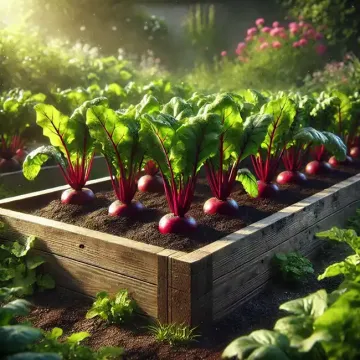Beets (Beta vulgaris) are a versatile and nutritious root vegetable that can thrive in a home garden. Known for their sweet, earthy flavor, beets are rich in essential vitamins and minerals, making them a popular choice for health-conscious gardeners. Here's a comprehensive guide on growing beets, from history and health benefits to culinary uses and growing tips.
History of Beets
Beets have a long and varied history, dating back to ancient civilizations. Originally cultivated in the Mediterranean, the earliest beet varieties were grown for their leaves rather than their roots. By the time of the Roman Empire, beets were appreciated for both their leafy greens and their roots, which were used for medicinal purposes and as a food source. Over centuries, selective breeding led to the modern beet varieties we know today, prized for their vibrant red roots, though yellow, white, and striped varieties also exist.
Health Benefits of Beets
Beets are packed with nutrients that support overall health. They are an excellent source of dietary fiber, folate, vitamin C, and manganese. One of their most notable components is betalains, a group of pigments responsible for the deep red and purple colors of beets. Betalains have powerful antioxidant and anti-inflammatory properties, which may help reduce the risk of chronic diseases. Beets are also known to improve cardiovascular health by lowering blood pressure due to their high nitrate content, which can enhance blood flow and oxygen delivery throughout the body.
Culinary Uses of Beets
Beets are incredibly versatile in the kitchen. Their sweet, earthy flavor makes them a great addition to salads, soups, and roasted vegetable dishes. They can be boiled, steamed, roasted, or even eaten raw, grated into slaws or smoothies. Beet greens are also edible and can be used in a similar way to spinach or Swiss chard. Pickled beets are a popular way to preserve their flavor, and they can be fermented into kvass, a traditional Eastern European beverage. For a unique dessert, beets can be used in cakes and brownies, adding moisture and natural sweetness.
Growing Tips for Beets in the Home Garden
1. Planting Beets
- Timing: Beets are a cool-season crop that can be planted in early spring or fall. In most climates, sow seeds directly in the garden as soon as the soil is workable, about 2 to 4 weeks before the last expected frost. For a fall harvest, plant beets 6 to 8 weeks before the first expected frost.
- Soil: Beets prefer well-drained, loamy soil with a pH between 6.0 and 7.0. The soil should be rich in organic matter, so it's a good idea to amend the garden bed with compost before planting.
- Spacing: Sow beet seeds about 1/2 inch deep and 1 to 2 inches apart in rows that are 12 to 18 inches apart. Thin seedlings to 3 to 4 inches apart once they are about 2 inches tall to give the roots space to develop.
2. Watering and Fertilizing
- Watering: Beets need consistent moisture to develop properly, especially during root formation. Water deeply and regularly, aiming for about 1 inch of water per week. Mulching around the plants can help retain soil moisture and prevent weeds.
- Fertilizing: Beets are light feeders but will benefit from a balanced fertilizer, especially one that is lower in nitrogen to avoid excessive leafy growth at the expense of root development. Apply fertilizer before planting and side-dress the plants as they grow.
3. Common Pests and Diseases
- Pests: Beets can be affected by common garden pests such as aphids, leaf miners, and flea beetles. Floating row covers can help protect young plants from insect damage. Handpicking and encouraging natural predators, like ladybugs, can also help control pest populations.
- Diseases: Beets are generally disease-resistant, but they can suffer from fungal issues like downy mildew, leaf spot, and damping-off in overly wet conditions. Good air circulation, proper spacing, and crop rotation can help prevent these problems.
4. Harvesting Beets
- Roots: Beets are typically ready to harvest 50 to 70 days after planting. The roots can be harvested when they are about the size of a golf ball for the best flavor and tenderness. Larger beets can become woody and lose their sweetness. To harvest, gently loosen the soil around the beet and pull it out by the tops.
- Greens: Beet greens can be harvested when they are young and tender, about 4 to 6 inches tall. Cutting a few leaves from each plant allows for a continuous harvest without harming root development.
5. Storage
- Short-term: Fresh beets can be stored in the refrigerator for up to two weeks. Cut off the greens to extend their shelf life, leaving about 1 inch of the stem to prevent bleeding.
- Long-term: Beets can be stored in a cool, dark place like a root cellar for several months. They can also be pickled, canned, or frozen for longer preservation.
Conclusion
Growing beets in your home garden can be a rewarding experience, offering delicious and nutritious produce throughout the growing season. With the right care, this hardy vegetable will reward you with vibrant, flavorful roots and nutrient-packed greens. Whether you're a seasoned gardener or just starting out, beets are an excellent addition to any garden plan.

